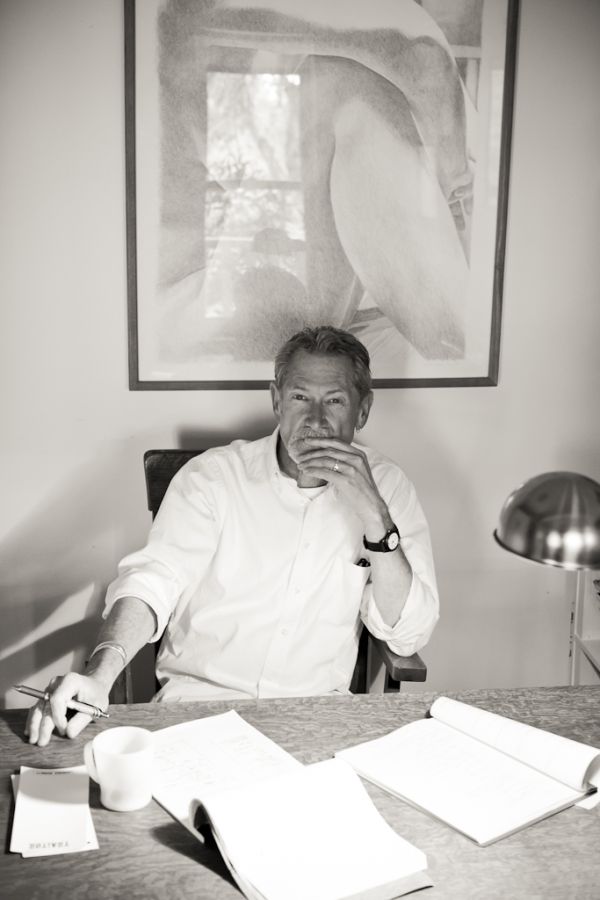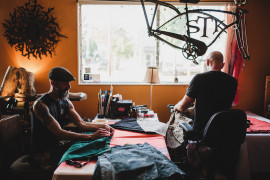Lean and tan, Laurence Bennett looks every bit the movie star. But as a production designer, Bennett is actually the wizard behind the lens. We all have a sense of what a cinematographer, an editor and a director does, but the production designer’s role is often cloaked in mystery. Bennett’s job is what he calls “the artistic author, responsible for bringing to life the entire world the characters inhabit on film.” Bennett’s film and TV credits include the just-released The Company You Keep and five-time Academy Award-winning The Artist, as well as Crash, The Valley of Elah, Freedom Writers, The Next Three Days, “Grey’s Anatomy” and “EZ Streets.” We caught up with Bennett at his restored 1904 farmhouse in Estacada. Here, with his wife, Nina, and a menagerie of animals, Bennett is able to recharge.
Your latest movie is the star-packed The Company You Keep (Robert Redford, Shia LaBeouf, Susan Sarandon, Stanley Tucci and Sam Elliott). What was it like to work with one of your idols, Robert Redford?
The experience of working with a filmmaker whom I’ve watched on screen for so long, and admire so greatly—professionally and personally—was extraordinary. Redford is incredibly collaborative and very visual; he studied art, painted for some time, and his wife, Sibylle, is a painter. We spent time looking at and discussing imagery in photographs and paintings to set the tone. We spent even more time discussing the script. That’s what we keep coming back to in pursuit of what the picture needs to be, how it needs to look.
For one set in particular that had great emotional significance to the characters and story, Bob [Redford] and I traded sketches about how it might be laid out, oriented in the landscape, and what physical attributes it should have. I found Andrew Wyeth’s work a touchstone for that set. A quintessentially American artist, he imbued even the most simple buildings and objects with history, subtext and resonance.
Can the discerning viewer recognize a Laurence Bennett movie? Are there certain consistencies?
I honestly don’t know that I’m the right person to answer that. While there are, of course, ongoing influences on my work, each film is unique in story, setting and tone. I would hope that the design for each responds to its particular needs of subject, themes and period.
You say that production designers have the least understood jobs in the cinematic arts, yet aren’t they the most important in terms of how we feel when we walk out of the theater?
As one of the visual authors, along with the director and cinematographer, the production designer is responsible for the look of the film. The PD deals with set design, locations, set dressing, props and interfaces with costume, hair, makeup, special effects, stunts and visual effects.
Art direction is, I think, the least understood of the cinematic arts because, if a movie is good, the design can easily go largely unnoticed. Our job is to imagine and create a living, breathing, believable world for the story—to support and enhance the story. If the viewer is brought into that world, we have succeeded.
Was there a defining moment when you knew you were made to work in movies?
No, rather, it was an evolution. Through my work and exploration of the arts, I was fortunate to discover what I should be doing, and how I could apply all my experience and interests to my role in filmmaking.
You log thousands of miles traversing the globe, working with A-list actors. Then you fly back home to a modest farm house in Estacada. Why here?
I have lived and worked in Oregon for periods of time over the past forty years, and Nina and I have lived in Estacada for seventeen. I’m blessed to have a life full of travel, typically on the road eight months a year. But life in Oregon provides a focus and grounding that I rely on and treasure. We enjoy a rich quality of life in the Northwest, surrounded by landscape that nurtures and inspires.
One of the most interesting questions you say you’ve ever been asked came recently, from an Estacada High School student who wondered whether you live your life through the filter of film. What did you tell her?
To take just one example, I asked her if she perhaps recognized ways in which her concept of love and romance had been formed through movies. I’ve no doubt that modern consciousness has been largely shaped by cinema.
So, how has film changed your life?
I believe that film, like all art, has the ability to transform self and society. Film has the capacity to engender empathy, to allow people to see commonality where they had previously only seen difference.
I’m blessed to work at something that I love—being part of telling stories, entertaining people, and hopefully inspiring and sometimes challenging them. I travel widely, and have the chance to go backstage into peoples’ lives and jobs, and to experience richness, beauty and diversity of life in our time. I know that cinema has enriched my life beyond words.
You say a “remarkable confluence of all kinds of things going right” must happen to make a good movie. What is an example of that magic in your films?
Howard Hawks on what makes a good movie: “Three great scenes, no bad ones.” A good movie begins with a good script. But everything else that goes into its making has to be spot-on as well. Every decision, large or small from everyone involved, contributes to how well it is realized. Not an easy feat.
And then to be successful, it has to be distributed and marketed well. I’ve done two indies that enjoyed significant success. While making Crash and The Artist, all those involved who brought their talent, commitment and passion to the projects sensed that we were making films that just might be very good. But both films’ paths to recognition were against incredible odds.
For your work on The Artist, you received an Academy Award nomination, and you won the César (the French version of the Academy Awards). Was your job more challenging because it is a silent film?
We did a tremendous amount of testing and research, the most important of which was watching film of the era. There are such beautiful movies from the teens and ’20s. I’d been quite familiar with the work of Chaplin, Keaton and others, but was introduced to masterpieces by Murnau, Vidor, Lang, and Von Sternberg.
We tried to emulate styles of films from the period, certainly. But one of the things I was most keen to have my team see and appreciate was the fun that those pioneers of film were having. They were inventing the language of cinema, and at the same time inventing the business—how films were made. I encouraged everyone who worked with me to identify with that spirit of playfulness and inventiveness.
You’ve been holding a script during our photo shoot with you. Is that where your creative process begins?
The first time I read a script, I watch the story in my mind. It’s an early version of the movie, lacking the fullness of what it will become. But it invariably contains some of the elements, visual themes, and tonalities of what I will eventually contribute to the whole. The process of prepping for production, though, involves collaboration with all the other contributors, and through that involvement my take on the look of the movie expands.
What’s next for Laurence Bennett?
I just got back from three-and-a-half weeks in Italy, scouting locations and assembling a crew for a fim with my friend, writer-director Paul Haggis. Third Person (Liam Neeson, Olivia Wilde) comprises three stories about relationships, each set in a different city: Rome, Paris and NYC.









